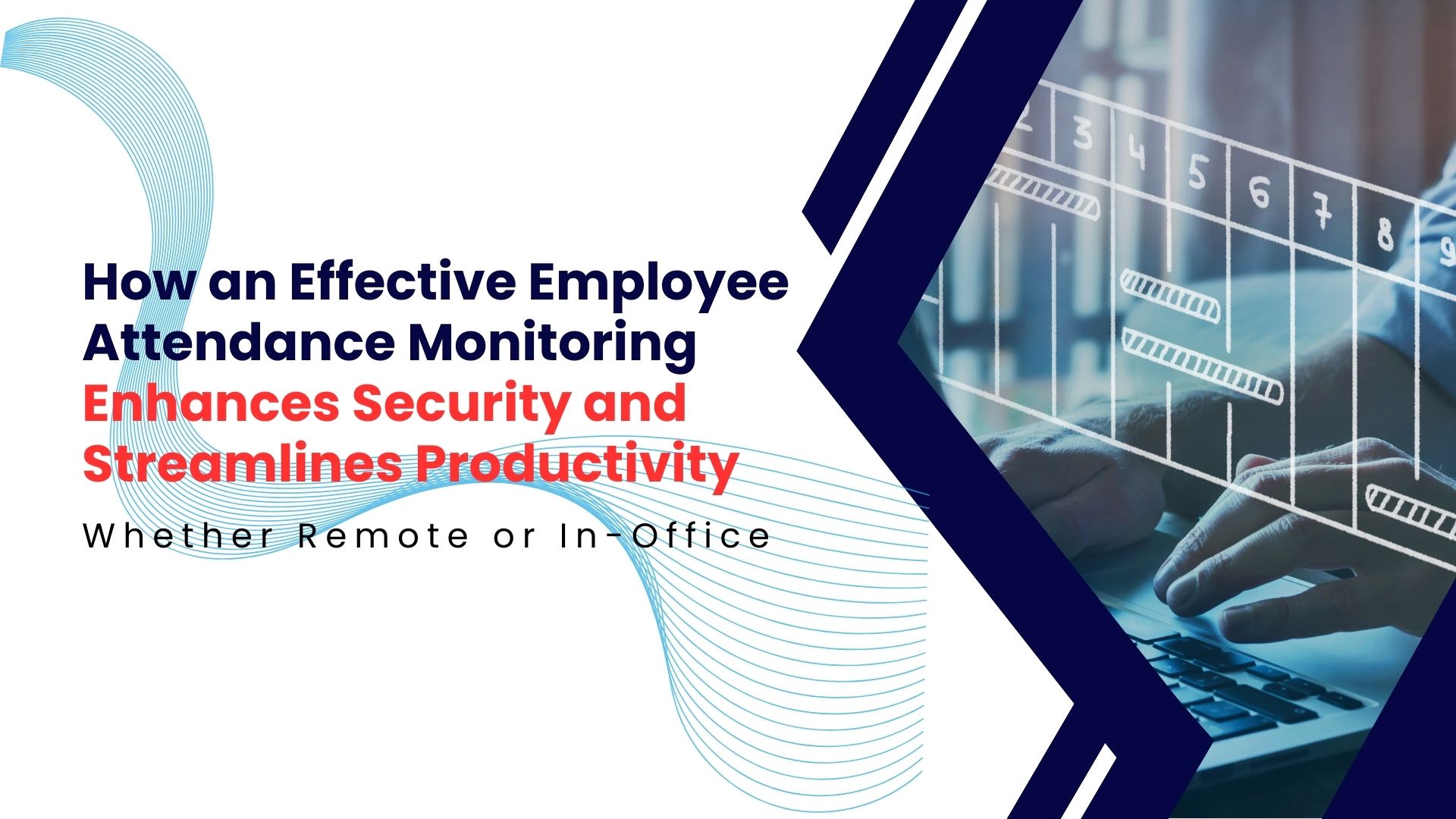In today’s fast-paced work environment, the way businesses manage their workforce has evolved, especially with the shift to remote work. One of the most crucial aspects of workforce management is employee attendance monitoring. As organizations continue to adapt to the new hybrid and remote work models, ensuring the productivity and security of employees no matter where they work has become a top priority.
Employee attendance monitoring is not just about tracking the hours worked; it plays a critical role in protecting sensitive business data, improving overall productivity, and maintaining a secure working environment. In this blog post, we’ll explore how modern attendance tracking solutions can significantly improve productivity, ensure security, and manage remote teams effectively, even when they’re scattered across the globe.
The Importance of Employee Attendance Monitoring
Employee attendance monitoring is essential for both physical office spaces and remote working environments. It helps businesses ensure that their employees are present when needed, that they follow their work schedules, and that their work aligns with the organization’s goals and objectives.
With attendance monitoring tools, organizations can:
Track Work Hours Accurately: Whether employees are working from an office or remotely, precise tracking of work hours is essential for accurate payroll management, client billing, and compliance with labor laws.
Reduce Time Theft: In a remote environment, there’s a risk of time theft where employees might not work for the entire duration of their shifts. Attendance monitoring helps eliminate such issues by tracking login times, task completions, and time spent on different projects.
Promote Accountability: By tracking attendance and work patterns, businesses can encourage employees to adhere to schedules and be accountable for their work.
Boost Employee Productivity: Accurate attendance monitoring gives managers insights into how much time employees spend on work, helping them identify potential productivity issues early and offer support where necessary.
Ensure Security of Business Data: Especially when dealing with remote employees, ensuring secure access to business data becomes crucial. Attendance monitoring systems can integrate with security protocols to ensure that sensitive business data remains protected.
How Employee Attendance Monitoring Improves Productivity
Employee attendance monitoring plays a direct role in improving overall productivity. Here’s how:
Optimized Resource Allocation: Through attendance data, managers can see which employees are consistently working and which may need additional support. This allows organizations to allocate resources more effectively, ensuring that employees are not overburdened or underutilized.
Time Management: With an employee attendance monitoring system, employees and managers can better manage time. For instance, attendance data can help identify peak productivity periods and times when employees are less engaged. This allows organizations to tailor workflows to make the best use of employee time.
Flexible Work Schedules: With flexible work hours becoming more common, employee attendance monitoring helps track when employees are working, regardless of location. By offering more autonomy to employees, businesses can increase job satisfaction and overall productivity.
Performance Tracking: Some employee attendance monitoring tools come with features that track not just attendance but also performance metrics such as task completion and quality of work. This helps managers assess productivity in real-time and offer targeted assistance or incentives.
Ensuring Security with Employee Attendance Monitoring
When employees work remotely, the challenge of securing sensitive business data becomes paramount. Attendance monitoring systems help ensure that only authorized personnel have access to your company’s systems and data. Here’s how:
Authentication Integration: Modern employee attendance monitoring systems come with integration features such as biometric authentication, multi-factor authentication, or facial recognition. These tools help ensure that employees are who they claim to be, reducing the risks of unauthorized access.
Geo-Fencing: For companies that need employees to be physically present at a specific location (such as a client site or company office), geo-fencing can be a game-changer. This technology allows employers to track when employees enter or leave a designated work zone. It prevents employees from clocking in or out of locations they shouldn’t be, helping to mitigate security risks.
Time-Tracking Compliance: Employees working remotely may be prone to irregular work hours. Through effective attendance monitoring, companies can ensure that their workforce adheres to time-related policies. This can include preventing unauthorized overtime, ensuring compliance with labor regulations, and safeguarding against data breaches from unauthorized work practices.
Audit Trails: Employee attendance monitoring tools often maintain audit trails of login times, task progress, and work patterns. These records can be invaluable in identifying security issues or breaches in case of an investigation, ensuring businesses have a clear understanding of what happened and when.
Managing Remote Teams Efficiently
Managing remote teams requires more than just employee attendance monitoring; it involves creating a system that fosters communication, accountability, and collaboration across dispersed locations.
Here’s how employee attendance monitoring tools help manage remote teams:
Streamlined Communication: Many attendance tracking tools offer integrations with communication platforms like Slack, Microsoft Teams, or Zoom. This means that when employees log in or out, their team members and managers can be notified, ensuring that communication remains transparent and on track.
Reduced Micromanagement: One of the biggest concerns of remote work is the lack of oversight. However, employee attendance monitoring systems allow managers to track key metrics, ensuring that employees are engaged without the need for micromanagement.
Remote Clock-In/Clock-Out Options: Modern attendance systems enable employees to clock in and out via mobile apps, desktops, or even through specialized hardware like fingerprint scanners. This ensures that attendance is accurate, no matter where employees are working from.
Workforce Analytics: Remote workforce management tools allow employers to track more than just attendance – they can also track performance, job satisfaction, and even engagement levels. These analytics help businesses make data-driven decisions and manage their remote teams more effectively.
Protecting Sensitive Business Data
Sensitive data protection is a major concern in any organization, but when employees work remotely, the risk of data breaches can increase. By integrating attendance monitoring systems with cybersecurity protocols, businesses can protect their data in several ways:
- Restricted Access to Sensitive Data: By integrating attendance monitoring with access control systems, companies can restrict access to sensitive data based on employees’ working hours. This ensures that only authorized personnel can access business-critical information during work hours, reducing the likelihood of data theft.
- Real-Time Alerts: Many modern attendance monitoring systems come with real-time alerts that notify managers if employees work outside their approved hours or access restricted systems. This provides immediate oversight and allows quick intervention if needed.
- Data Encryption: Attendance data, just like any other business data, should be encrypted to prevent unauthorized access. Using secure, encrypted channels for transferring employee attendance information ensures that businesses are not exposed to potential risks.
- Data Retention Policies: Good attendance monitoring systems include built-in data retention policies. These ensure that sensitive data, such as time logs, are stored securely for a set period and then deleted or anonymized, preventing potential data breaches in the long term.
Employee attendance monitoring is no longer just a tool for tracking employee hours; it has evolved into a comprehensive solution that can enhance productivity, ensure data security, and streamline the management of remote teams. Whether your employees work from the office or remotely, leveraging advanced attendance monitoring systems can help safeguard sensitive business data, improve overall efficiency, and ensure your team remains engaged and accountable. With the right tools, businesses can foster a more secure, productive, and collaborative environment for their employees regardless of their location.
Sources:
- HR Technologist – https://www.hrtechnologist.com/
- Forbes – https://www.forbes.com/
- SHRM – https://www.shrm.org/
- TechCrunch – https://techcrunch.com/
- Business News Daily – https://www.businessnewsdaily.com/





